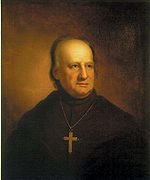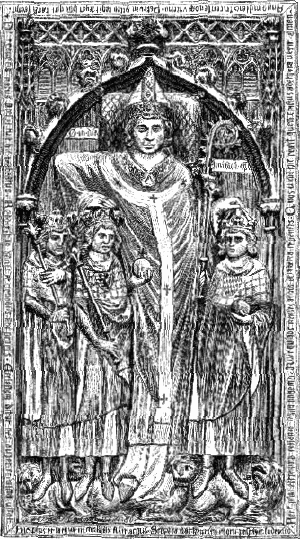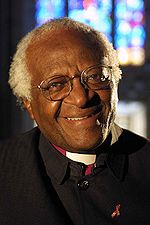Archbishop
| Part of a series of articles on Christianity | ||||||

| ||||||
|
Foundations Bible Christian theology History and traditions
Topics in Christianity Important figures | ||||||
|
Christianity Portal | ||||||
In Christianity, an archbishop is an elevated bishop. The word comes from the Greek αρχι, which means "first" or "chief," and επισκοπος, which means "overseer" or "supervisor."
In the Catholic Church and others, an archbishop often lead a diocese of particular importance called an archdiocese, or in the Anglican Communion an Ecclesiastical Province. In ancient times, the office of archbishop often involved substantial political power as well as spiritual authority, being second only to that of of "patriarch," signifying an archbishop of one of the most important cities of the ancient Christian world, such as Rome, Antioch, Jerusalem, Alexandria, and Constantinople.
An archbishop is equivalent to a bishop in sacred matters but simply has a higher precedence or degree of prestige. Thus, when someone who is already a bishop becomes an archbishop, that person does not receive new Holy Orders or any other sacrament. However a person can become an archbishop without first being a bishop, in which he must be ordained a bishop before being created an archbishop and installed.
History
In the early Christian church, the office of bishop emerged from an increasing need for supervision, direction, and the resolution of disputes, both theological and ecclesiastical. In the earliest letters of Saint Paul, the offices of apostles, prophets, and teachers seem to have been the most important. Early sources also refer to elders and occasionally "overseers" (episcopi), although scholars dispute whether the authentic Pauline letters actually refer to the office we know today as bishop. The Book of Acts, however, indicates that James, the brother of Jesus, held central authority to resolve disputes at Jerusalem; and tradition holds that Peter became the first bishop of Rome.
By the early second century, bishops were clearly present in several Christian churches, although it is not certain that they ruled their churches singly. Indeed, there is evidence that in some cases these "overseers" acted as a board of elders, making their office similar to that of the presbyters. By the later second century the so-called "monarchical episcopacy" had begun to emerge in the "orthodox" churches as the bulwark of correct teaching authority against the threat of "heresy." On the other hand, many of the most important heresies of succeeding centuries were led by bishops of the most important cities of Christianity.
Meanwhile, the number of bishops had also multiplied. Country bishops—known as chorespicopi—were notorious for their lack of education and sophistication, and to their vulnerability to theological notions deemed heretical by their more sophisticated counterparts in the cities. The bishops of great cities naturally came to hold greater prestige and authority than their country brethren. To these were given the title of metropolitan or archbishop. Even the title of pope once belonged to several metropolitan bishops at once, being synonymous with the title of patriarch.
Western Christianity
In western Christianity, an archbishop is entitled several privileges that a simple bishop does not receive. First, an archbishop's coat of arms looks different. Roman Catholic archbishops are allowed ten tassles a side on their coat of arms, while a bishop only receives six. In addition, an archbishop can also place an archiepiscopal cross (two bars instead of one) behind his shield. In the Roman Catholic church this cross used to be carried immediately before archbishops in liturgical processions, but this is now not always done. In the Anglican Communion an archiepsicopal or primatial cross is carried before an archbishop in procession. Also in liturgical protocol, archbishops precede simple bishops.
Catholic archbishops' dress and are referred to in the same manner as a normal bishop. Exceptions occur in the Anglican Communionwhere an archbishop is styled The Most Reverend while a simple bishop is styled The Right Reverend.
Archbishops of archdioceses
Most western archbishops are called so because they are in charge of an archdiocese, a diocese of particular importance. This importance is usually due to the archdiocese being the metropolitan see (episcopal domain) of the ecclesiastical province in which the see is located. These metropolitan archbishops, in addition to the usual ceremonial privileges of archbishops, hold the responsibilities of a metropolitan bishop over the diocesan and auxiliary bishops within a metropolitan's province. Only archbishops are privileged to wear the pallium, an ecclesiastical stole originally reserved to the pope alone. If an archdiocese is particularly significant, the archbishop may become a cardinal.
Sometimes, a diocese is an archdiocese because of its history or size and not because of its jurisdictional importance. Their archbishops, while retaining the ceremonial privileges of archbishops, act as normal residential bishops and usually are subject to antoerh metropolitan bishop. Most of these non-metropolitan archdioceses are located in Europe, a few examples being the Archdiocese of Strasbourg, which is not in any ecclesiastical province, and the Archdiocese of Avignon, whose archbishop is under the authority of the Metropolitan Archbishop of Marseille.
Other archbishops
A residential archbishop who resigns his see and does not take up another one retains the title Archbishop Emeritus of the last see he occupied before the resignation. This occurs when an archbishop retires or is transferred to some other non-diocesan office, such as the Roman Curia. This recent canonical innovation was instituted to conserve titular sees for active auxiliary bishops and members of the Roman Curia who have not had a diocesan appointment yet. In the past, the pope would normally bestow a titular see on every retired bishop and every bishop who transferred to the Curia.
Finally some archbishops hold their privileges ad personam. This means that the archiepiscopal dignity is conferred on them alone and not their diocese. The primates of the Anglican Communion are this kind of archbishop, since they only hold archiepiscopal rights for the duration of their presidency. In the Latin-rite Roman Catholic Church, the Pope grants ad personam archiepiscopal privileges, which usually endure perpetually.
Eastern Christianity
In the Eastern churches archbishops and metropolitans are distinct, although a metropolitan may be referred to as metropolitan archbishop. In the Slavonic and Antiochian traditions, a metropolitan outranks an archbishop. The reverse is the situation in the Greek tradition. The Oriental Orthodox generally follow the pattern of the Slavic Orthodox with respect to the archbishop/metropolitan distinction.
The change in the Greek tradition came about lelatively late Greek Orthodox history, because the diocesan bishops of ancient sees came to be styled "metropolitans," short for "metropolitan bishops." The Slavonic and Antiochian churches continue to follow the older tradition, where an archbishop is a senior bishop in charge of a major see, and a metropolitan is a bishop in charge of a province which may include a number of minor and/or major sees.
In the Greek tradition, diocesan bishops of autocephalous churches such as the Church of Greece are now metropolitans, and an archbishop holds his title as an indication of greater importance for whatever reason. The Greek Orthodox Archdiocese of America is the notable exception in the Greek practice where diocesan bishops carry the title of metropolitan. In other churches under the jurisdiction of the Ecumenical Patriarchate such as the Greek Orthodox Archdiocese of Australia the ruling bishop is the archbishop while the other bishops are auxiliary bishops with titles of the ancient sees.
See also
- Major archbishop
- List of Bishops and Archbishops
- Archbishop of Canterbury
- How the Church of England is organised
External Links
Archdiocese of Avignon (-Apt, Cavaillon, Carpentras, Orange, e Vaison) - Retrieved September 22, 2007.
Credits
New World Encyclopedia writers and editors rewrote and completed the Wikipedia article in accordance with New World Encyclopedia standards. This article abides by terms of the Creative Commons CC-by-sa 3.0 License (CC-by-sa), which may be used and disseminated with proper attribution. Credit is due under the terms of this license that can reference both the New World Encyclopedia contributors and the selfless volunteer contributors of the Wikimedia Foundation. To cite this article click here for a list of acceptable citing formats.The history of earlier contributions by wikipedians is accessible to researchers here:
The history of this article since it was imported to New World Encyclopedia:
Note: Some restrictions may apply to use of individual images which are separately licensed.



